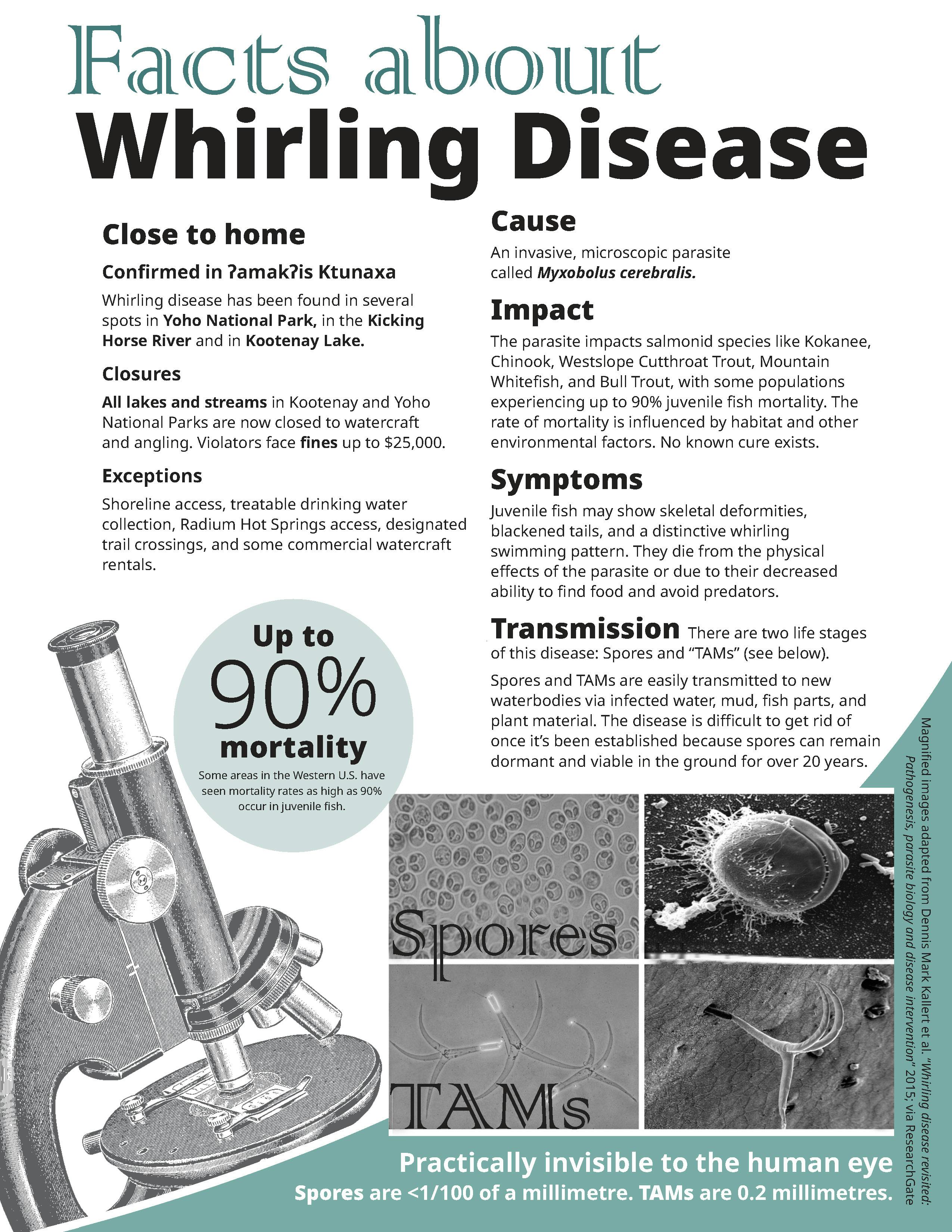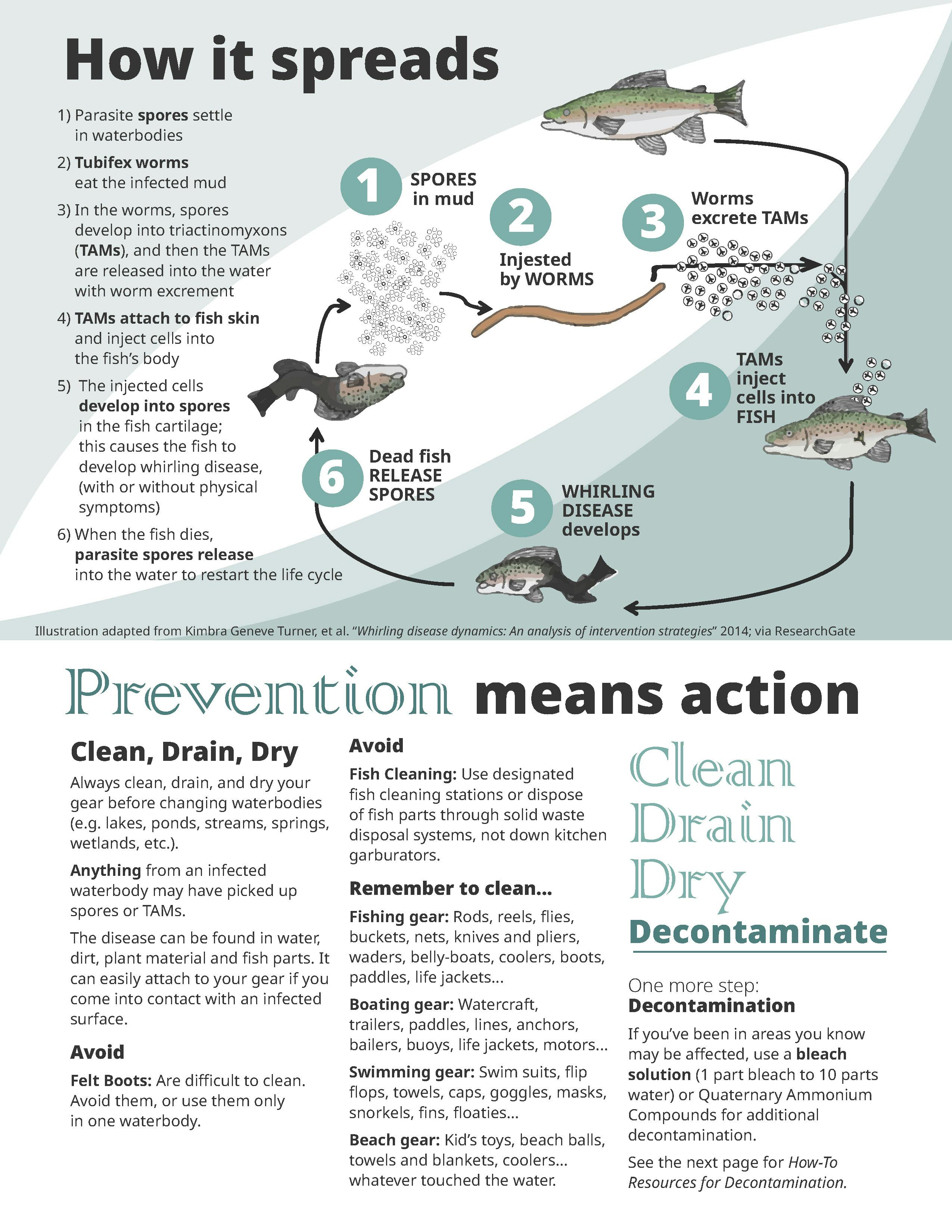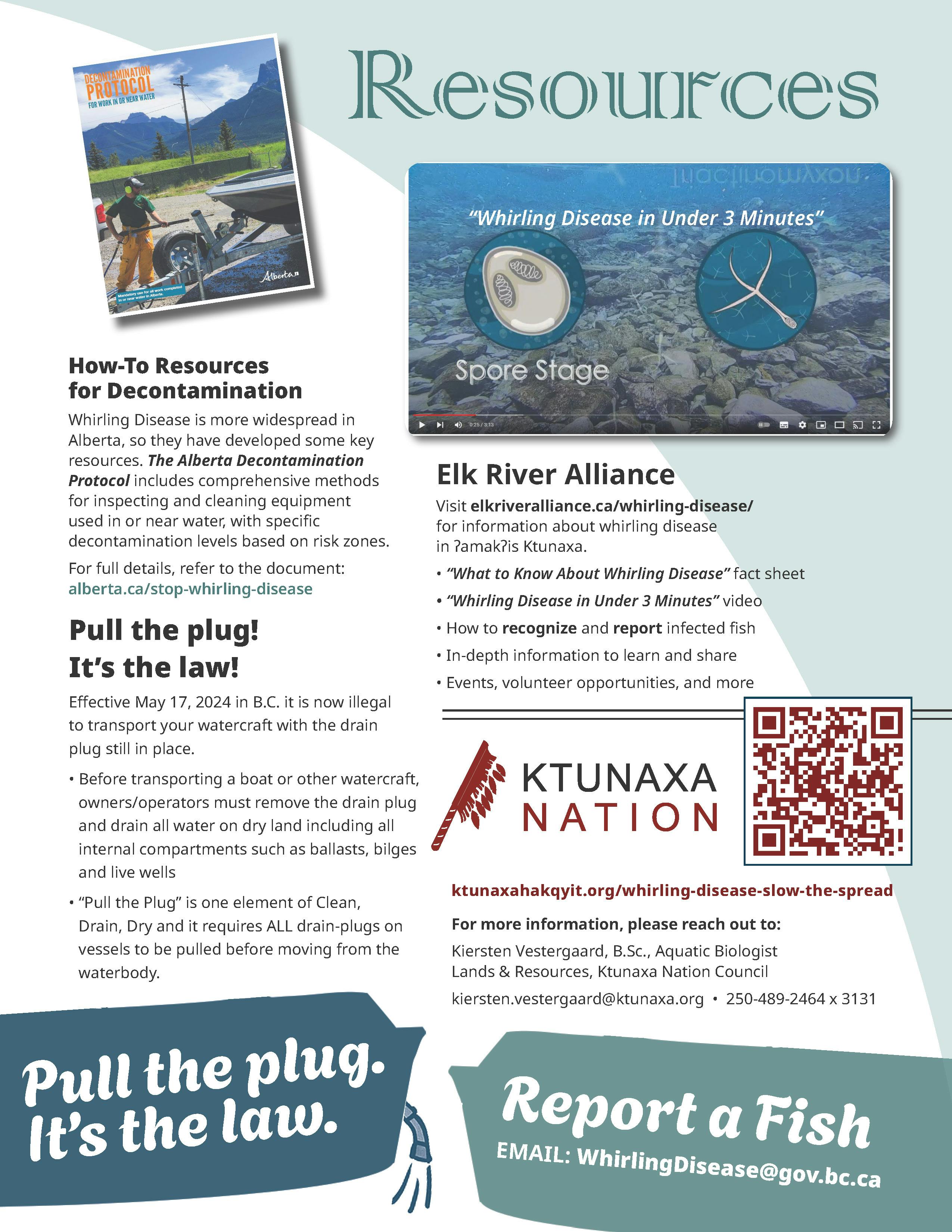Whirling Disease: Slow the spread
Whirling disease is a deadly threat to local fish populations, and it is now present in ʔamakʔis Ktunaxa.
Found in several spots throughout Yoho National Park, this disease can devastate species like Kokanee and Rainbow Trout.
The good news is we can all play a part in slowing its spread.
By adopting simple habits like cleaning, draining, and drying all of our water gear, we can protect waterways and help them to support healthy fish populations for future generations.
You can find the Ktunaxa Nation Council Fact Sheet on Whirling Disease in the documents and gallery to the right, and you can read it below.
More resources will be added as we develop them.
Whirling disease is a deadly threat to local fish populations, and it is now present in ʔamakʔis Ktunaxa.
Found in several spots throughout Yoho National Park, this disease can devastate species like Kokanee and Rainbow Trout.
The good news is we can all play a part in slowing its spread.
By adopting simple habits like cleaning, draining, and drying all of our water gear, we can protect waterways and help them to support healthy fish populations for future generations.
You can find the Ktunaxa Nation Council Fact Sheet on Whirling Disease in the documents and gallery to the right, and you can read it below.
More resources will be added as we develop them.
-
Fact Sheet

Whirling disease is a deadly threat to local fish populations, and it is now present in ʔamakʔis Ktunaxa.
 Found in several spots throughout Yoho National Park, this disease can devastate species like Kokanee and Rainbow Trout.
Found in several spots throughout Yoho National Park, this disease can devastate species like Kokanee and Rainbow Trout.The good news is we can all play a part in slowing its spread.
By adopting simple habits like cleaning, draining, and drying all of our water gear,
we can protect waterways and help them to support healthy fish populations for future generations.Read on to learn more about the disease and the microscopic parasite that causes it, its potential impacts,
and what you can do to reduce its spread through waterways in ʔamakʔis Ktunaxa.Facts About Whirling Disease
It's close to home: It's been confirmed in ʔamakʔis Ktunaxa
Whirling disease has been found in several spots in Yoho National Park,
including Wapta Lake, Monarch Creek, Emerald Lake, Finn Creek, and the Kicking Horse River.Closures
In 2024, all lakes and streams in Kootenay and Yoho National Parks are closed to watercraft and angling. Violators face fines up to $25,000.Exceptions
Shoreline access, treatable drinking water collection, Radium Hot Springs access, designated trail crossings, and some commercial watercraft rentals.Cause
An invasive, microscopic parasite called Myxobolus cerebralis.Impact
The parasite impacts salmonid species like Kokanee, Chinook, Westslope Cutthroat Trout, Mountain Whitefish, and Bull Trout,
with some populations experiencing up to 90% juvenile fish mortality. The rate of mortality is influenced by habitat and other environmental factors. No known cure exists.Symptoms
Juvenile fish may show skeletal deformities, blackened tails, and a distinctive whirling swimming pattern.
They die from the physical effects of the parasite or due to their decreased ability to find food and avoid predators.Transmission
There are two life stages of this disease: Spores and “TAMs” (see below).Spores and TAMs are easily transmitted to new waterbodies via infected water, mud, fish parts, and plant material.
The disease is difficult to get rid of once it’s been established because spores can remain dormant and viable in the ground for over 20 years.How it spreads
1) Parasite spores settle in waterbodies
2) Tubifex worms eat the infected mud
3) In the worms, spores develop into triactinomyxons (TAMs), and then the TAMs are released into the water with worm excrement
4) TAMs attach to fish skin and inject cells into the fish’s body
5) The injected cells develop into spores in the fish cartilage; this causes the fish to develop whirling disease, (with or without physical symptoms)
6) When the fish dies, parasite spores release into the water to restart the life cycle
Prevention Means Action
Clean, Drain, Dry
- Always clean, drain, and dry your gear before changing waterbodies (e.g. lakes, ponds, streams, springs, wetlands, etc.).
- Anything from an infected waterbody may have picked up spores or TAMs.
- The disease can be found in water, dirt, plant material and fish parts. It can easily attach to your gear if you come into contact with an infected surface.
Avoid Felt Boots: They are difficult to clean. Avoid them, or use them only in one waterbody.
Fish Cleaning: Use designated fish cleaning stations or dispose of fish parts through solid waste disposal systems, not down kitchen garburators.
Remember to clean...
Fishing gear: Rods, reels, flies, buckets, nets, knives and pliers, waders, belly-boats, coolers, boots, paddles, life jackets...
Boating gear: Watercraft, trailers, paddles, lines, anchors, bailers, buoys, life jackets, motors...
Swimming gear: Swim suits, flip flops, towels, caps, goggles, masks, snorkels, fins, floaties...
Beach gear: Kid’s toys, beach balls, towels and blankets, coolers... whatever touched the water.
One more step: Decontamination
If you’ve been in areas you know may be affected, use a bleach solution (1 part bleach to 10 parts water) or Quaternary Ammonium Compounds for additional decontamination.
How-To Resources for Decontamination
Whirling Disease is more widespread in Alberta, so they have developed some key resources.
The Alberta Decontamination Protocol includes comprehensive methods for inspecting and cleaning
equipment used in or near water, with specific decontamination levels based on risk zones.For full details, refer to the document: alberta.ca/stop-whirling-disease
In brief, the document covers:
Inspection and Cleaning Methods
Use Quaternary Ammonium Compounds (QAC) for disinfecting equipment.
Soak submersible items in a disinfectant bath for at least 10 minutes.
Non-submersible items should be wiped or sprayed with disinfectant, ensuring surfaces remain wet for 10 minutes.
Prevention of Spread
Avoid transferring water between watersheds or different waterbodies.
Decontaminate watercraft and trailers between each use, unless using in the
same waterbody.
Equipment Handling
Learn procedures for decontaminating various types of equipment, including sensitive electronic components.
Use pump-up style sprayers for applying disinfectants to large or non-submersible items.
Handling and Disposal
Learn safe disposal of solutions made with the disinfectants.
Consult with local authorities before disposing larger volumes of disinfectant through sanitary sewers.
More info?
We endorse the work of the Elk River Alliance
Visit elkriveralliance.ca/whirling-disease/ for the most up-to-date outreach info on whirling disease in ʔamakʔis Ktunaxa.
• “What to Know About Whirling Disease” fact sheet
• “Whirling Disease in Under 3 Minutes” video
• How to recognize and report infected fish
• In-depth information to learn and share
• Events, volunteer opportunities, and more
To Report a Fish
Please forward any reports or inquiries regarding whirling disease in B.C. to
WhirlingDisease@gov.bc.caFor more information about Ktunaxa Nation Council's response to whirling disease,
please contact
Kiersten Vestergaard, B.Sc., Aquatic BiologistLands & Resources, Ktunaxa Nation Council
kiersten.vestergaard@ktunaxa.org • 250-489-2464 x 3131
Whirling Disease Fact Sheet
Important Links: Whirling Disease
- Province of B.C.: Overview
- Province of B.C. Background and Guidance Information
- Province of B.C. Decontamination Protocol
- Parks Canada: Protect park waters: preventing aquatic invasive species
- Canada: Fact Sheet
- Elk River Alliance
- Province of Alberta: Quick Facts
- Province of Alberta: Infographic
- Infection zones in BC
Who's Listening
-
KV
Phone 250-489-2464 ext 3131 Email kiersten.vestergaard@ktunaxa.org





